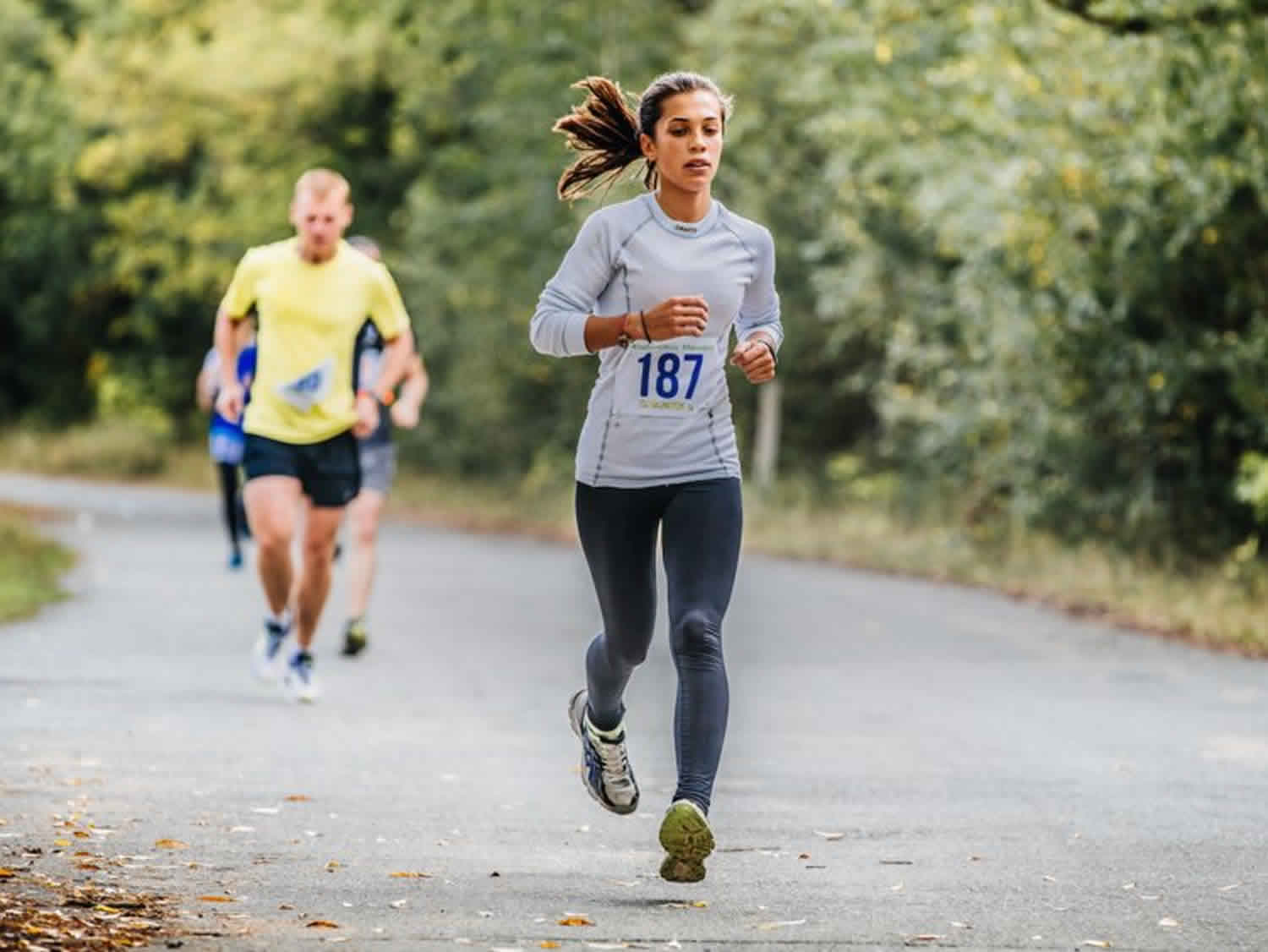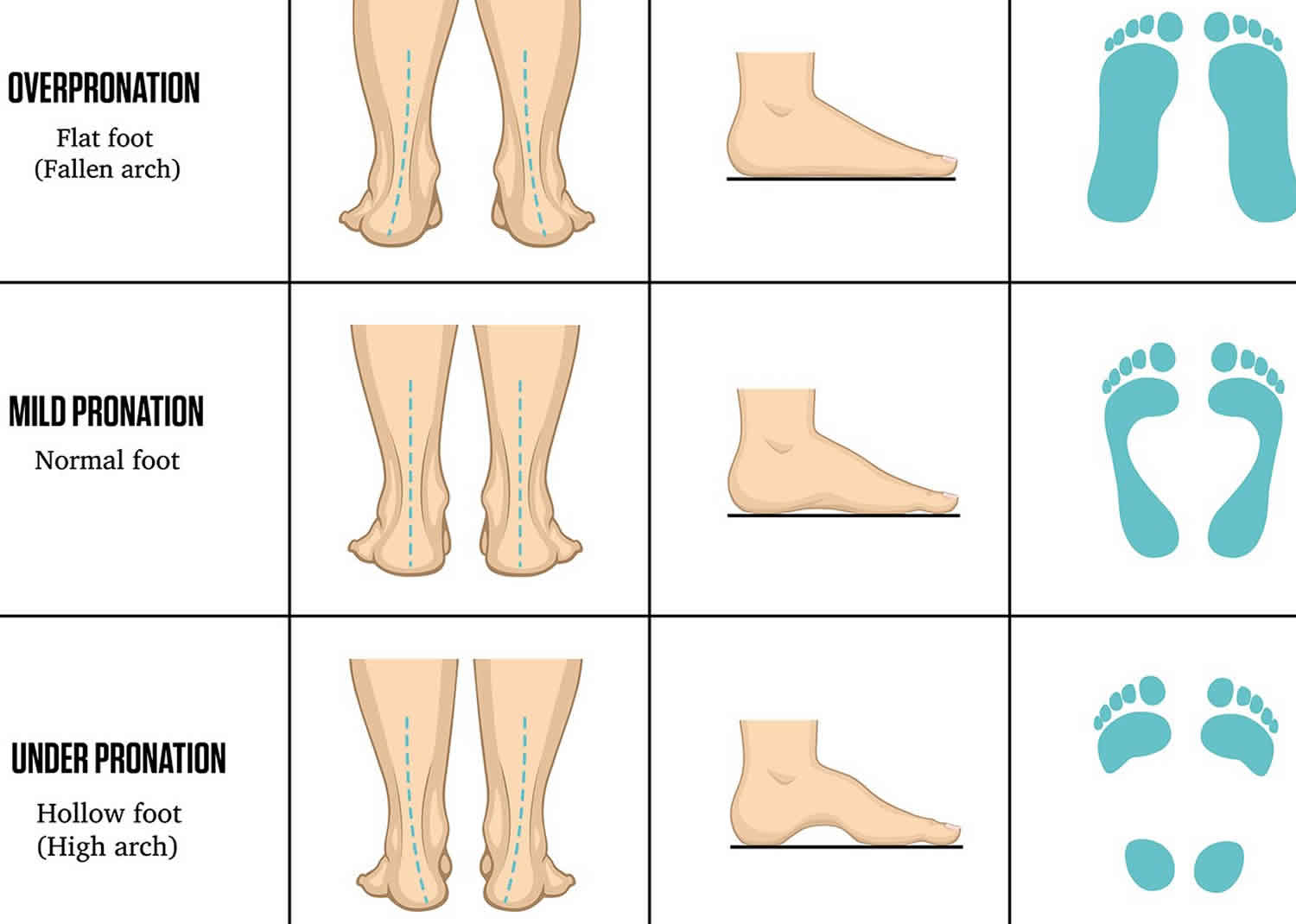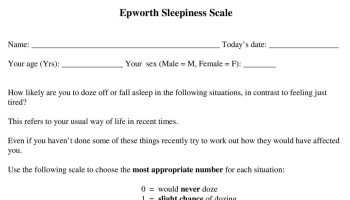Contents
What is overpronation
Overpronation or excessive pronation or eversion in frontal plane at ankle joint in heel-toe running, refers to the tendency of the medial bones to rotate inward too much, causing the arch to flatten. Overpronation is correlated with lower extremity overuse injuries and musculoskeletal pathologies, such as patellofemoral joint syndrome 1. In athletes, foot, ankle, calf and low back pain can result from faulty mechanics and overpronation in which pressure is unequally applied to the inside of the foot. Orthotics and inserts are often prescribed to limit the overpronation to tackle the problems.
Overpronation problem isn’t so much one of gait as it is of weight distribution. While some degree of over- and underpronation are to be expected in most people, excessive rotational motion one way or the other can increase the risk of overuse and stress injuries.
Overpronation can destabilize your body when walking and running. Your foot continues to roll inward even after it’s made its landing. What happens next depends on the structure of your feet, ankles, and calves, but many runners experience nasty stress injuries:
- Achilles tendinitis
- Heel spurs
- Plantar fasciitis
- Shin splints
Overpronation can also play a role in acute injuries, like ankle sprains.
Ankle pronation (and its opposite, supination) refers to the calcaneal motion with respect to the talus orientation at the subtalar joint. In heel-toe walking and running, ankle pronation is accompanied by knee flexion and internal tibial rotation. At heel strike, pronation of subtalar joint unlocks the midtarsal joints and allows the foot to absorb shock and adapt to uneven terrains. In take off, subtalar joint supinates and relocks the midtarsal joints, which turns the foot into a rigid lever for push-off 2. The axis orientation of the subtalar joint is about 42 and 23 degrees to the human anatomical transverse plane and sagittal plane respectively 3. Since the axis does not coincide with the human anatomical reference frame, the subtalar joint movement is often described as a tri-planar motion. The motion in frontal plane is often termed calcaneal or heel inversion/eversion 4, which describes the foot segment rotation about the anterior-posterior axis 5.
Moulded foot orthoses have been shown to be successful in treating such injuries and reducing the symptoms 6 by realigning the foot anatomy, controlling excessive pronation and reducing internal tibial rotation 7. Numerous prophylactic or therapeutic devices, such as motion control shoe, orthoses, orthotic devices, inserts and others, have emerged to limit the pronation range during running. In evaluating the effect of these devices to control pronation during running, orthopaedics and biomechanics researchers often investigate the rearfoot kinematics, or to be specific, the calcaneal motion in respect to the talus bone. Previous researches showed that the effects are still unclear 8. Scherer 9 showed that orthotic inserts are useful in relieving heel and plantar fascilitis pain, however, Gross and co-workers 10 showed no improvement or even increased symptom severity in runners being prescribed with orthotics. Moreover, there are many types of commercially available orthotic in the marker, including half insert or full insert, with different degree of support in medial and lateral arch-heel regions 11. Therefore, the effect of orthotic inserts is product-specific, thus, biomechanics evaluation of orthotic inserts is necessary.
Figure 1. Overpronation (right foot)
Overpronation vs Underpronation
Overpronation refers to the tendency of the medial bones to rotate inward too much, causing the arch to flatten. Underpronation, also known as supination, refers to the opposite.
What causes overpronation?
Genetics and poor running form can contribute to overpronation, experts attribute the prevalence of overpronation to three main characteristics of modern living:
- Unsupportive footwear
- Muscular weakness in the legs
- Hard, flat surfaces of sidewalks, homes, and workplaces.
These factors loosen joints in the foot over time, causing structural changes to the bones and soft tissues. These changes then influence the “kinetic chain,” affecting the body’s ability to distribute weight to properly absorb the shock of movement.
Overpronation signs and symptoms
One of the strangest things about overpronation is that it often feels like a lower back problem. Patients seeking relief often don’t realize that the pain originates in their gait and posture. Some common symptoms of overpronation include:
- Pain which stems from the bottoms of the feet and heels and spreads to the thighs and back
- Stiffness in the feet or legs
- Swelling in the heel or ankle
Common injuries of overpronators
When walkers and runners overpronate, the big toe and the second toe absorb too much shock, and take on too much of the work on push-off. As a result of this imbalance of pressure, overpronators are more susceptible to stress injuries such as:
- Shin splints
- Runner’s knee
- Stress fractures
- Plantar fasciitis
- Achilles tendinitis
Overpronation test
Overpronation isn’t always obvious. Most people take the way that they walk or run for granted. You can always have your gait analyzed by a foot and ankle specialist, but there are some ways to tell at home.
Flat feet
First, overpronators typically have flat feet, and extremely flexible arches. That excessive movement makes it hard for your body to support your weight while running.
Wet foot test
You can check this using the wet foot test. Dip just the sole of your foot into a pan of water. Be careful not to soak the entire foot and arch – just the bottom!
Next, step onto a newspaper or paper bag. If your footprint leaves you asking, “what arches?” then you’re probably an overpronator.
Wear and tear on your shoes
You can also tell from the wear and tear on your shoes. Flip your running shoes over. If the heel and ball of the foot leading into the big toe are all worn in, then overpronation is the likely culprit.
Figure 2. Overpronation test
Overpronation treatment
Wear supportive shoes. Look for shoes with thick, firm, multi-density soles and “motion stability.” These can stop your foot from rolling too far inward.
Use orthotic inserts. In many cases, you don’t have to buy completely new footwear. Overpronators can visit their foot and ankle specialist for an evaluation and a custom insert fitting.
Orthotic inserts can lift your arches and cut short the inward rolling motion. This will help to distribute weight evenly across the foot and correct alignment.
Focus on your stride. Improving your form can help mitigate discomfort and prevent future injuries. Taking short, quick steps instead of long, drawn-out strides can minimize the foot’s rotation, and decrease your chances of over-striding.
Supportive shoes
To keep your arches from collapsing with every step, you need sturdy, supportive footwear. Shoes with proper arch support will keep your foot in alignment and give you stability. Avoid any shoes with flexible soles, especially trendy “minimalist” shoes.
Even if you get brand new, motion-controlling shoes, they may not be enough to correct the effects of overpronation. That’s why our doctors can’t recommend this next solution highly enough.
Overpronation exercises
You can also employ stretching and strengthening exercises. If your doctor says it’s okay, you can use a foam roller to roll out the tightness in your calves that can exacerbate problems associated with overpronation.
Stretching can help reduce pain and increase your range of motion. Here are some stretches you can try at home that take five minutes or less:
- Toe and heel lifts
- Calf raises. Stand with your feet shoulder-width apart, toes pointed forward. Slowly, lift your heels off the ground and lower them back down. Repeat 10 times. You can even try these on one foot at a time.
- Ball roll. Massage the arches of your feet with a golf ball or a frozen water bottle. Repeat with each foot for one minute.
- Toe touches
- Ankle rolls
- Point, flex, curl. Sit on the floor with your legs straight out in front. Point the toes, then flex them back. Finish with a toe curl. Repeat this 10-12 times.
While foam rolling and stretching the legs can help with the pain, no amount of physical therapy can “fix” overpronation. Think of the inserts as you would eyeglasses. Eyeglasses can improve eye functionality in people with poor vision, but you can’t significantly strengthen the eye muscles through exercise.
Custom insoles
They’re specially fitted to your feet and tailored for your activity purposes. Insoles can both treat current injuries – like plantar fasciitis – and prevent new injuries from occurring.
According to a 2017 study 12 published in the Journal of Biomechanics, custom insoles minimized the angle of pronation at groundstrike, and raised the height of the arch. When feet are supported in correct alignment, also the position of the knees, pelvis, and hips are corrected, thereby providing a solid foundation for the entire body. Forget the soft and foamy models you find at the drugstore. What overpronators really need is structure, experts recommend a semi-flexible plastic at a minimum, which can then be covered with a cushion for comfort.
- Fong DT, Lam MH, Lao ML, et al. Effect of medial arch-heel support in inserts on reducing ankle eversion: a biomechanics study. J Orthop Surg Res. 2008;3:7. Published 2008 Feb 20. doi:10.1186/1749-799X-3-7 https://www.ncbi.nlm.nih.gov/pmc/articles/PMC2266906/[↩]
- Cheung RT, Ng GY, Chen BF. Association of footwear with patellofemoral pain syndrome in runners. Sports Medicine. 2006;36:199–205. doi: 10.2165/00007256-200636030-00002[↩]
- Yamashita MH. Evaluation and selection of shoe wear and orthoses for the runner. Physical Medicine and Rehabilitation Clinics of North America. 2005;16:801–829. doi: 10.1016/j.pmr.2005.02.006[↩]
- Stacoff A, Reinschmidt C, Stussi E. The movement of the heel within a running shoe. Medicine and Science in Sports and Exercise. 1992;24:695–701[↩]
- Lundberg A, Svensson OK, Bylund C, Goldie I, Selvik G. Kinematics of the ankle/foot complex – Part 2: pronation and supination. Foot and Ankle. 1989;9:248–253[↩]
- Landorf KB, Keenen AM. Efficacy of foot orthoses; What does the literature tell us? J Am Podiatr Med Assoc. 2000;90:149–158[↩]
- Nawoczenski DA, Cook TM, Saltzman CL. The effect of foot orthosis on three-dimensional kinematics of the leg and rearfoot during running. Journal of Orthopaedics and Sports Physical Therapy. 1995;21:317–327[↩]
- Razeghi M, Batt ME. Biomechanical analysis of the effect of orthotic shoe inserts – A review of the literature. Sports Medicine. 2000;29:425–438. doi: 10.2165/00007256-200029060-00005[↩]
- Scherer PR. Heel spur syndrome. Pathomechanics and nonsurgical treatment. Biomechanics graduate research group for 1988. Journal of the American Podiatric Medical Association. 1991;81:68–72[↩]
- Gross ML, Davlin LB, Evanski PM. Effectivess of orthotic shoe inserts in the long-distance runner. American Journal of Sports Medicine. 1991;19:409–412. doi: 10.1177/036354659101900416[↩]
- Nigg BM, Stergiou P, Cole G, Stefanyshyn D, Mundermann A, Humble N. Effect of shoe inserts on kinematics, center of pressure, and leg joint moments during running. Medicine and Science in Sports and Exercise. 2003;35:314–319. doi: 10.1249/01.MSS.0000048828.02268.79[↩]
- Kosonen, J., Kulmala, J-P., Muller, E., and AvelaJ. Effects of medially posted insoles on foot and lower limb mechanics across walking and running in overpronating men. Journal of Biomechanics. (2017) http://dx.doi.org/10.1016/j.jbiomech.2017.01.041[↩]







